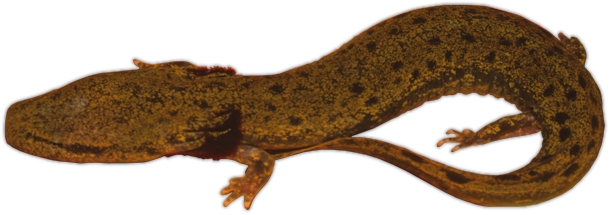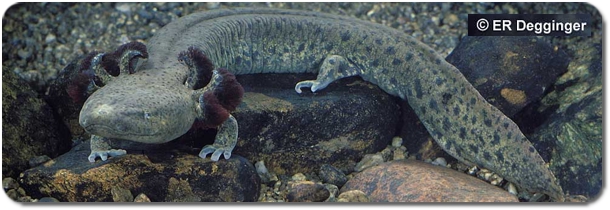Common Mudpuppy
What it looks like
The Common Mudpuppy is a large salamander. It can be as long as 49 cm, but most adult mudpuppies are around 20 to 30 cm long. On top they are brown or gray with dark spots. Their bellies are light gray. Adult Mudpuppies keep their gills all their life. They have 3 pairs of gills that look like red feathers attached to the sides of the head. They also have a fin on their tail like the young of other salamanders.
Look-alikes
Tiger Salamander larvae (both kinds) can look like a Common Mudpuppy, but they will have a rounder head and five toes on their hind feet. Common Mudpuppies have only four toes on all their feet.
Name
The Common Mudpuppy gets its name because people once thought it could bark like a dog and it lives in muddy places. It doesn't really bark, but can make a squeek or grunt if it is picked up. There are other kinds of Mudpuppies. Ours is the most common kind of Mudpuppy.
Scientific Name
The Common Mudpuppy's scientific name is Necturus maculosus. Learn what that means on this page: Scientific Names.
Where it lives
Common Mudpuppies live in rivers and lakes, they never come out onto land. They like rocky bottoms more than muddy bottoms. They live in eastern central North America and are found in southeastern Manitoba. Where they live in this province isn't well known.
Where Common Mudpuppies live in North America.
Habits
In the daytime, Common Mudpuppies hide under rocks or sticks in the water. They are more active at night. They walk along the bottom of lakes or rivers hunting for food. Even in winter they stay active and continue to look for food. People ice-fishing often catch Common Mudpuppies!

Another good look at a Common Mudpuppy.
Food Web
Common Mudpuppies eat all kinds of small animals that live in the water. They will eat small fish, crayfish, insects and snails.
Large fish will eat Common Mudpuppies. So will wading birds like herons or diving ducks like mergansers. Common Snapping Turtles will eat them, too.
Life Cycle
Common Mudpuppies mate in the fall, but the females don't lay their eggs until the next spring. In April or May they lay about 100 eggs. They stick them to rocks or sticks in the water. It takes about 30 to 50 days for the eggs to hatch.
The female stays with her eggs until they hatch. Then she leaves the larvae. A larva grows its legs when it is about 1 month old. Common Mudpuppy larvae have light and dark stripes. It may take more than 2 years to grow to adult size and loose its stripes.
Numbers
No one knows how many Common Mudpuppies might live in one lake or river in Manitoba, but in some rivers they are very common.
Special Things
The Common Mudpuppy is Manitoba's biggest salamander and our largest amphibian! A Common Mudpuppy never "grows up". It keeps its gills to breathe with and its tail fin all its life and never leaves the water.
How to Find Common Mudpuppies
Looking under rocks in large streams or rivers may be one way to find a Common Mudpuppy. Looking in clear streams at night with a strong flashlight may let you see one. Seine or dip nets may be useful to catch mudpuppies. Large minnow traps baited with meat of some sort have been used to capture them.
Use by People
Some people use Common Mudpuppies as bait to catch fish.
Special Note
There are very few pictures or videos of Common Mudpuppies from Manitoba. If you catch or see one and take a photo or video, please send it along to NatureNorth.com at this address: Email NatureNorth.com.
| Go to reptiles! Back to: Amphibians and Reptiles Front Page |
